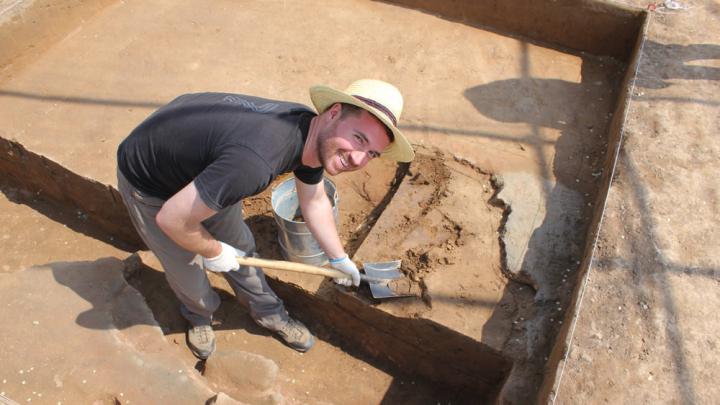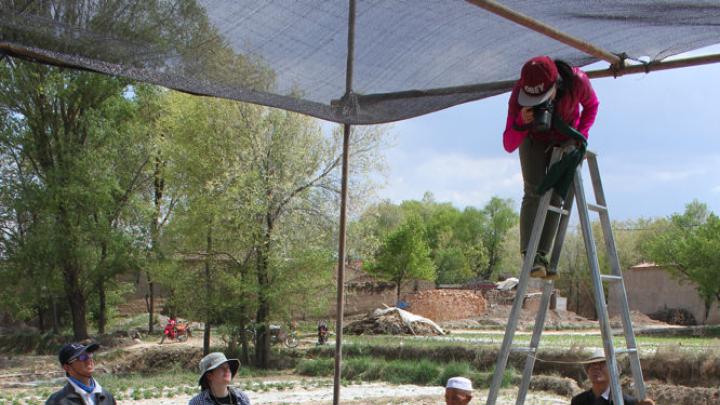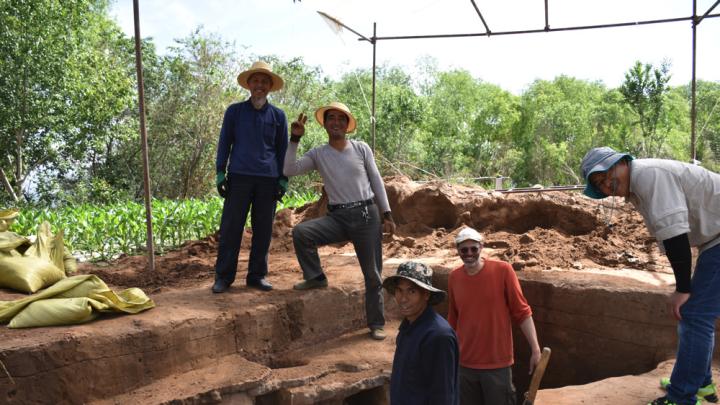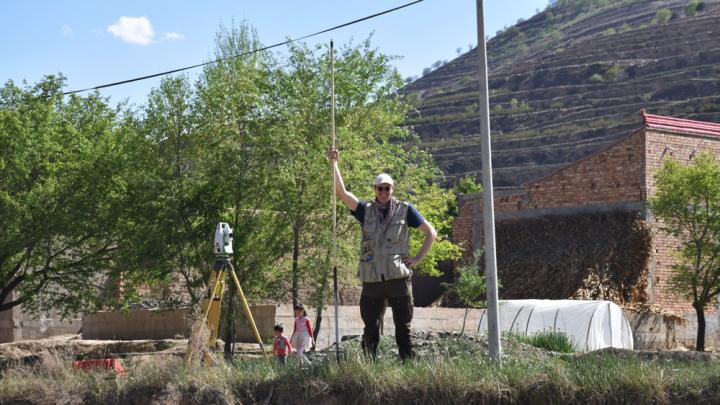Editor’s note: Hudson professor of archaeology Rowan K. Flad, a scholar of ancient China (read about his work in “Chinese Pottery: The First Five Millennia”), recently returned from Gansu Province, where he and colleagues undertook their first full season of important new excavations, aimed at advancing understanding of how early Chinese settlements adapted new technologies, grew, and interacted with one another. The project is part of Flad’s broader work on the origins and development of socially complex societies in China during late prehistory—particularly the third and second millennia b.c.e.—during which major transformations took place. This dispatch from the field suggests both why it is challenging to undertake this kind of research—from lining up partners and official permissions to the logistics of lodging and feeding a team working on a distant site—and the potential rewards
The beginning of the summer of 2017 marked the first full season of the five-year old “Tao River Archaeological Project” (TRAP), during which a collaborative group led by myself, as well as archaeologists from Peking University (Prof. Li Shuicheng) and the Gansu Provincial Institute of Archaeology (Dr. Wang Hui) could carry out excavations without an unreasonably short time in the field. TRAP was begun in 2012 to investigate technological changes in Northwest China during the late third and early second millennia b.c.e., a period during which new materials, like metals, were introduced to the region, along with new domesticated animals and plants (including cattle, sheep, goats, and horses, and wheat and barley)—all seemingly at different times and places. To get a sense of local processes of technological change during these 2,000 years, we have been focusing on understanding both these technological introductions and local developments within one river valley. We chose the Tao River valley in southern-central Gansu because a large number of prehistoric sites are known from the region. There has also been a long history of archaeological work here, although almost all the work to date has focused on burials, and until recently very little of the archaeological research in the valley has been conducted or reported systematically.
In the first several years of our project, we conducted survey work under the direction of the Gansu Provincial Institute of Archaeology. This arrangement allowed us to visit more than 50 sites in the valley that we thought might be ripe for further work and conduct some preliminary surface collection at each. With that background, in 2013 we prepared a proposal to the National Bureau of Cultural Heritage to conduct further survey and excavation at some sites as an international collaborative field project involving Harvard University, Peking University, and the Gansu Provincial Institute of Archaeology in Lanzhou. In October 2015, we were finally granted permission for a five-year project that will involve additional survey and excavations at some of a list of nearly two dozen sites in the region.
Permission obtained, our excavation team first broke earth in July 2016—but that was a short season. The surface conditions, climate, and other factors make May and June better months than later in the summer for work in the Tao River region (spring or fall would be good times, too, but class schedules at Harvard make these periods more difficult.) Fortunately, that initial work was really fruitful, despite having only about 10 days in the field.
We excavated two small units—one four square meters and one 10, both at the site of the important Qijiaping site: the location where archaeologists first identified a ceramic repertoire that is characteristic of a particular tradition in Northwest China that we now, based on the name of this site, call the “Qijia Culture.” (“Archaeological cultures” are typically distinguished by various aspects of their material record that are thought to reflect different traditions of manufacture, different material and social concerns, different communities of practice, possibly ethnic differences, and generally different “cultures,” broadly speaking. Ceramics, because they preserve well and their designs and forms are sensitive to relatively minor differences in production processes, are commonly relied upon as a lynchpin for defining such archaeological cultures.)

Yangxi Wang and Jada Ko starting survey at the Xindian Site on May 13, 2017.
Photograph by Rowan Flad
Our objective was to investigate “anomalies” that we had previously identified in geophysical data we collected at the site. Using a device that measures the strength of the earth’s magnetic field across different parts of the site, we can identify places where there are stronger or weaker magnetic signals than the surrounding background, and often these deviations are related to archaeological material. Our two excavation units were placed over two locations with strong magnetic signals, and we hoped for the sorts of remains that would help us start to get detailed chronological and spatial control over the remnants of everyday life. That year we uncovered a couple of trash pits and the top of what appeared to be the upper part of a kiln—exactly the sorts of things we were hoping for. This year our goal was to do more of the same: expanding our excavations to another site, and to continue the work on the kiln and elsewhere at Qijiaping.
Our 2017 team converged on Gansu Province in the second week of May. Some team members are based locally in Lanzhou City, the capital of Gansu, but most of the team came in from other parts of China or from abroad. I flew in from Beijing, fortunate to avoid a repeat of the nearly 48 hours of flight delays I experienced last year due to heavy smog. Other team members flew to Lanzhou from Wuhan, Hong Kong, Shanghai, and Shandong, some connecting directly after international flights and some travelling after already being in China for a while or from their home bases in various parts of China. Other team members took a train to Lanzhou from Xi’an. Trains to Lanzhou are typically a nicer way to arrive in the Gansu capital because the Train station is in the city, not too far from the Institute of Archaeology and the nearby hotel where we stay. The airport, in contrast, is far outside the city, over an hour away by car in even the best traffic. Fortunately, a high speed rail line has recently been completed that connects the airport to downtown Lanzhou, making transportation into the city much easier and more predictable. Even more fortunately, given that I had a fair amount of luggage, a driver from the Gansu Provincial Institute was able to meet me and a couple of colleagues who arrived around the same time and bring us to our hotel.
Our goals for the excavations were threefold:
- First, continue excavations at Qijiaping in order to investigate contexts that could be compared with the refuse pit we excavated the previous year and understand the kiln-like feature we started to expose.
- Second, evaluate the site of Xindian, another culture “type-site” that post-dates the Qijia Culture and has not been systematically investigated previously.
- And third, conduct excavations at a site called Huizuiwa, contemporary with Xindian, where we had previously done preliminary survey work and geophysics.

Jaclyn Li taking photos of artifacts in the laboratory at the Gansu Provincial Institute of Archaeology in Lanzhou on June 7, 2017.
Photograph by Rowan Flad
Our team fluctuated over the course of the season, with some participants coming early, and others joining later. The field director from the Gansu Provincial Institute of Archaeology was Zhou Jing, and we were joined by a couple of participants from other Chinese institutions this year: Zheng Xiuwen, from the Shanghai Museum, for the full season, and, briefly Guo Rongzhen from Shandong University, Su Xin from Wuhan University, and Wang Hui and Li Zhipeng from the Chinese Academy of Social Sciences, Institute of Archaeology. (Li had spent a year at Harvard as a Luce /ACLS [American Council of Learned Societies] Scholar in 2008-2009. Although the project fully engages the three principal collaborating institutions, this year we had a heavy contingent of people with other sorts of Harvard affiliations: Yitzchak Jaffe, Ph.D. ’16 (now at the Institute for the Study of the Ancient World at NYU), and Jade d’Alpoim Guedes, Ph.D. ’13, RI ’13 (now at University of California, San Diego); current Harvard Ph.D. student Jada Ko, incoming Harvard Ph.D. student Zhang Chengrui, current undergraduate Jaclyn Li ’20, and alumna Katherine Brunson ’08, a 2015-16 postdoctoral fellow in the Fairbank Center for Chinese Studies, now at Brown University. We were also joined by Ling-yu Hung (Indiana University), who also was a recent visiting scholar at the Fairbank Center (when she organized the Art Museums’ exhibition of Neolithic pottery); Yangxi Wang, a former postdoctoral affiliate of the department of anthropology; Andrew Womack, a current Ph.D. student at Yale; and Anke Hein, Moores associate professor in Chinese archaeology at Oxford’s School of Archaeology.
Our work for the season went well. We excavated two areas at Qijiaping. Near the kiln discovered in 2016, we excavated two units (T1 and T3) to clarify the kiln, and on the northern part of the site we excavated one unit (T2) and discovered a couple of superimposed trash pits. At Huizuiwa we excavated one unit (T1) that contained a complicated set of levels and pits filled with ash and trash that went nearly two meters deep. At Xindian, and around Qijiaping, we conducted extensive surface surveys to establish the scope and scale of those two sites and set the stage for additional future research.
To provide a glimpse of our daily process of thinking about our work, I reproduce here, verbatim, my end-of-day notes from one average day during the middle of the season. The excerpt should provide a glimpse of the way we spent our days during our five weeks in the field [comments in square brackets were added to explain elements of the daily log not otherwise self-explanatory]. Over successive seasons of excavation, laboratory analysis of findings, and comparison of discoveries from multiple sites, we will move toward developing our theories about the growth and development of these communities, the technologies they employed, and the spread of such knowledge in this part of China 5,000 years ago.
May 24, 2017—Sanjiaji, Guanghe County, Gansu Province, China
I spent the whole day today at Huizuiwa. Here we are digging a 2x2 m portion of a 2x5 m unit first, and if we have time and inclination, will probably expand to excavate the entire 2x5 m trench. Kate and Yitzchak started this yesterday and immediately below the topsoil it became rather complicated with apparent evidence for three separate entities (pits?) within the excavation area. One in the center is the most obvious, with most of the “pit” seemingly contained within the unit, and they had begun to excavate half of that. I joined them for the day and we continued exploring that pit, and also tried to make sense of the rest of the loci in the unit over the course of the day.
By the end of the day our working hypothesis was that there is a pit in the center of the 2x2 (a little west of center) that is the most recent entity. This pit seems to have multiple layers of material. Outside of this pit and more or less surrounding it is another locus, that may itself be a shallow pit or possibly a lens of cultural material into which the pit cut. In the Northeast corner, there is a darker brown area, with a lot of ash and charcoal, that seems to be a layer of ashy soil. Tomorrow this locus will be explored more clearly.

Yitzchak Jaffe at the excavation area at Huizuiwa on May 24, 2017
Photograph by Rowan Flad
The excavations today recovered a fair amount of pottery and bone. All of the material is consistent with the Xindian style of coarse pottery. Among the bone are some sheep/goat mandibles and other bones that are consistent with sheep/goat size mammals. We also found at least one worked bone object. We collected a number of charcoal samples, as well as sediment samples.
The soil in the excavation unit is very fine, and the dust gets everywhere. It is nearly impossible to keep the unit clean in any meaningful way that allows for interpretation of the stratigraphy. Today it was cloudy and cool for most of the morning, and then after lunch it started to rain. The rain was steady, and at some times hard. We were lucky that the night watchman at the site actually misunderstood Zhou Jing’s instructions about covering the excavation unit with plastic and put the plastic over the frame that was erected to create a shade over the unit. Because they put the plastic there, it was possible to excavate during the rain, and actually quite comfortable, albeit a little cool. Some rain might have made the soil behave a little more, but otherwise the shade was very useful.
The survey team today was most of the rest of the TRAP team. Anke went off to spend two days with Ms. Fan visiting potters so Yanxi was the survey team leader. They continued to expand our survey area between Qijiaping and Dayatou [another nearby site being investigated by the TRAP project. Dayatou predates the Qijia culture and was not a focus of the 2017 work.] Working with her today were Andrew, Chengrui, and Xiuwen. Jaclyn washed more pottery in the work station, while Zhou Jing continues to try to solve the problem with the local villager who would not let us continue work on the kiln. By lunch time, finally, utilizing some pressure from above, the villager acquiesced. I am not sure what this bodes for future work in the same area, or even at the site, but at least we can continue this year. Unfortunately, the rain was as hard at Qijiaping as at Huizuiwa, so the Qijiaping team came back to the hotel after lunch and a bit more time in the work station.
In the evening, we ate across the river from Sanjiaji. Ramadan starts tomorrow, and apparently many if not most stores and restaurants in Sanjiaji (and perhaps all of Guanghe) will be closed for the next month! We were not really prepared for this, but will need to figure out our meals even more carefully. Li Zhipeng and Wang Hui will leave tomorrow after collecting OSL [Optically Stimulated Luminescence—a technique commonly used for dating geological samples based on the last time they have been exposed to sunlight] samples from Huizuiwa and Wotuo Nanping [a site investigated by the TRAP team several years ago that dated to the Banshan phase of the Majiayao culture in the region, predating the Qijia Culture. Unfortunately, this site was destroyed by sand mining between the time we first visited the site and the next year, when we intended to work on the site more thoroughly.] I had a meeting with Zhipeng and Kate in the evening to talk about the Oracle Bone database project for which we are forming an official international collaboration. Hopefully this will help Zhipeng within CASS [Chinese Academy of Social Sciences] as apparently they are looking to generate more of these sorts of relationships.












